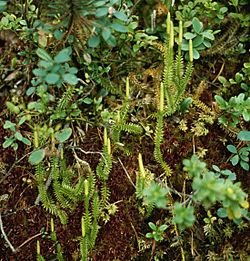Clubmoss facts for kids
Quick facts for kids Clubmosses |
|
|---|---|
 |
|
| Lycopodiella cernua with close-up of branch | |
| Scientific classification | |
| Kingdom: | |
| Division: | |
| Class: |
Lycopodiopsida
|
Clubmosses are a very old group of plants. They belong to a larger group called Lycopodiophyta. These are some of the first plants that grew on land!
These plants look a lot like the first vascular plants. Vascular plants have special tubes to carry water and nutrients. Clubmosses have small, scale-like leaves. Their stems often branch into two parts, which is called dichotomous branching.
Clubmosses make tiny spores instead of seeds. These spores are found in special cases called sporangia. These sporangia are usually at the bottom of the leaves.
Did you know that a powder made from dried clubmoss spores was used a long time ago? In Victorian theaters, this powder, called lycopodium, created cool flame effects. When blown into a cloud, it burned quickly and brightly. It made a flash of light but didn't create much heat. People thought it was safe back then!
Contents
Exploring Clubmosses
Clubmosses are a fascinating part of the plant kingdom. They are often found in forests and damp areas. They can grow on the ground or even on other plants.
What Makes Them Special?
Clubmosses are different from many other plants you see today. They don't have flowers or seeds. Instead, they reproduce using spores. This is similar to how ferns reproduce.
Their small leaves are often packed tightly along the stem. This gives them a mossy or club-like look. Some clubmosses have upright stems, while others creep along the ground.
Types of Clubmosses
Scientists divide clubmosses into two main families:
Typical Clubmosses (Lycopodiaceae)
These are the clubmosses you might imagine. Their spores are often found on a special club-shaped part of the plant. This part is called a strobilus. It looks a bit like a small cone.
The cells of these clubmosses usually have 34 chromosomes. Chromosomes are tiny structures inside cells that carry genetic information.
Firmosses (Huperziaceae)
Firmosses are another type of clubmoss. Their spore-bearing parts are found right where the leaves meet the stem. These leaves look like regular leaves, not special club-shaped ones.
Firmosses have a different number of chromosomes. Their cells typically have 67 chromosomes. This difference helps scientists tell them apart from typical clubmosses.
Ancient Clubmosses
Millions of years ago, during the Carboniferous period, some clubmosses grew into huge trees! These ancient tree-like clubmosses are now extinct. They formed vast forests that later turned into the coal we use today.
These giant clubmosses, like Lepidodendron, could grow over 30 meters (100 feet) tall. They had thick, scaly trunks. Their fossils tell us a lot about Earth's ancient plant life.
Images for kids
-
A fossil showing the outside of a Lepidodendron trunk. This one was found in Ohio and is from the Upper Carboniferous period.
See also
 In Spanish: Lycopsida para niños
In Spanish: Lycopsida para niños





